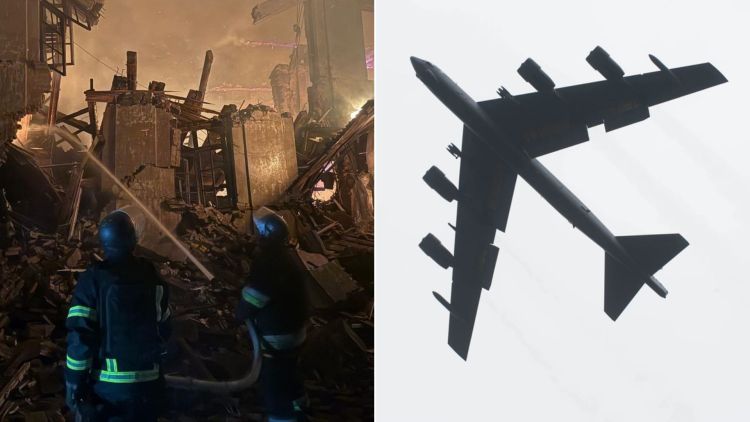Start your weekend with a quick rundown of top defense and global affairs headlines from around the world this Saturday, November 2.
Today, we’re diving into the latest US military reinforcements in the Middle East, a new wave of military aid heading to Ukraine, and North Korea’s pledge of unwavering support for Russia. We’ll also cover Japan’s newest amphibious vessel, India’s ambitious submarine expansion, and China’s noticeable silence amid rising tensions. Here’s what you need to know to stay up to speed.
Middle East B-52 Reinforcement
Defense Secretary Lloyd Austin announced Friday that they are reinforcing US military presence in the Middle East by sending B-52 Stratofortress bombers, tankers, and Navy destroyers to the region, just as the USS Abraham Lincoln carrier group prepares to head home.
With Israel’s conflicts in Gaza and Lebanon ongoing, the US is emphasizing its commitment to support Israel and protect its interests against threats from groups like the Houthis.
The B-52s add strategic strength, especially as there will be a brief period with no American aircraft carrier in the Middle East.
The Abraham Lincoln, currently in the Gulf of Oman, will be replaced by other Navy destroyers, likely from Europe or the Indo-Pacific, to fill the gap.
Eventually, the USS Harry S. Truman carrier group is expected to move into the Mediterranean, though it won’t arrive before the Lincoln departs. This shift reflects an overall decrease in personnel, but the bomber deployment ensures continued US firepower in the region.
More Weapons, Ammo, and Armor for Ukraine
Also on Friday, the Pentagon announced a fresh $425 million military aid package for Ukraine as it faces growing pressure from Russian forces, now reportedly joined by over 10,000 North Korean troops.
Start your weekend with a quick rundown of top defense and global affairs headlines from around the world this Saturday, November 2.
Today, we’re diving into the latest US military reinforcements in the Middle East, a new wave of military aid heading to Ukraine, and North Korea’s pledge of unwavering support for Russia. We’ll also cover Japan’s newest amphibious vessel, India’s ambitious submarine expansion, and China’s noticeable silence amid rising tensions. Here’s what you need to know to stay up to speed.
Middle East B-52 Reinforcement
Defense Secretary Lloyd Austin announced Friday that they are reinforcing US military presence in the Middle East by sending B-52 Stratofortress bombers, tankers, and Navy destroyers to the region, just as the USS Abraham Lincoln carrier group prepares to head home.
With Israel’s conflicts in Gaza and Lebanon ongoing, the US is emphasizing its commitment to support Israel and protect its interests against threats from groups like the Houthis.
The B-52s add strategic strength, especially as there will be a brief period with no American aircraft carrier in the Middle East.
The Abraham Lincoln, currently in the Gulf of Oman, will be replaced by other Navy destroyers, likely from Europe or the Indo-Pacific, to fill the gap.
Eventually, the USS Harry S. Truman carrier group is expected to move into the Mediterranean, though it won’t arrive before the Lincoln departs. This shift reflects an overall decrease in personnel, but the bomber deployment ensures continued US firepower in the region.
More Weapons, Ammo, and Armor for Ukraine
Also on Friday, the Pentagon announced a fresh $425 million military aid package for Ukraine as it faces growing pressure from Russian forces, now reportedly joined by over 10,000 North Korean troops.
This latest assistance includes a range of weapons from US stockpiles, like National Advanced Surface-to-Air Missile Systems (NASAMS) munitions, Stinger missiles, High Mobility Artillery Rocket Systems (HIMARS) ammo, and Stryker armored carriers, plus medical and demolition equipment.
See below for the complete list of the military aid included:
- Munitions for NASAMS
- Stinger missiles
- Counter-Unmanned Aerial Systems (c-UAS) equipment and munitions
- Air-to-ground munitions
- Ammunition for HIMARS
- 155mm and 105mm artillery ammunition
- Tube-launched, Optically tracked, Wire-guided (TOW) missiles
- Javelin and AT-4 anti-armor systems
- Stryker Armored Personnel Carriers
- Small arms and ammunition
- Medical equipment
- Demolitions equipment and munitions; and
- Spare parts, ancillary equipment, services, training, and transportation.
Defense Secretary Austin noted that more aid was on the way during his recent visit to Kyiv, and the US remains committed to supporting Ukraine, coordinating with 50 allied countries through the Ukraine Defense Contact Group.
The announcement comes as Russia ramps up its attacks on eastern cities, with Kharkiv hit by a powerful 500-kilogram (1,100-pound) bomb on Thursday, killing three civilians and injuring many others.

This latest military assistance brings total US support for Ukraine to $60.4 billion since the start of the invasion.
North Korea Vows to Stand By Russia ‘Till Victory’ in Ukraine War
North Korea’s Foreign Minister Choe Son Hui pledged Friday full support for Russia in the Ukraine war, stating that North Korea would stand with Russia “until the day of victory.”
At a meeting in Moscow with Russian Foreign Minister Sergei Lavrov, Choe emphasized the growing “military comradeship” between the two countries, praising the leadership of Kim Jong Un and Vladimir Putin.
Lavrov highlighted the “very close ties” between their militaries, hinting at collaboration on shared security tasks.
Neither minister mentioned reports from the US and NATO that North Korea has deployed around 10,000 troops to Russia, with some likely set to enter combat soon.
Choe accused the US and South Korea of plotting nuclear strikes against North Korea (without providing evidence) and warned that tensions on the Korean Peninsula could become “explosive.”
Lavrov, in turn, criticized the West’s actions, suggesting they pushed Russia and North Korea closer together.
China’s Silence Speaks Volumes
The US and South Korea are urging China to use its influence to rein in North Korea after Pyongyang reportedly sent thousands of troops to support Russia’s efforts in Ukraine.
Despite private talks with top US diplomats, China has yet to comment publicly, maintaining that it advocates for peace talks and sees the Russia-North Korea partnership as its “own matter.”
Secretary of State Antony Blinken urged China to intervene on Thursday, highlighting global expectations. But, China remains cautious, likely balancing its ‘no limits‘ partnership with Russia while trying to avoid further tension with the West.
“…China should do more to curb the DPRK’s provocative actions and to stop support for Russia’s defense industrial base, which is helping to perpetuate the conflict and the aggression by Russia in Ukraine,” Blinken said in a Joint Press Availability last October 31.
DPRK stands for Democratic People’s Republic of Korea, which is the official name of North Korea.
Experts believe China views the Russia-North Korea alliance as destabilizing in the region, which complicates its goals for peace on the Korean Peninsula.
Analysts speculate that Chinese President Xi Jinping may choose to stay silent to avoid risking relations with the West while also not wanting to see Russia fail.
Beijing’s continued “radio silence” signals its discomfort with the situation, suggesting it’s caught between support for Moscow and its own regional stability interests.
Japan’s JS Nihonbare Amphibious Warship
Japan’s Self-Defense Force just launched a new amphibious vessel, JS Nihonbare, designed to enhance logistics and defense for its southwestern islands.
Built to transport vehicles and supplies quickly, Nihonbare will support a newly-formed Maritime Unit focused on resupply and reinforcement. This unit, expected to include members from all branches of the Self-Defense Force, will be up and running by the end of FY 2024.
The push to establish this unit reflects Japan’s shift in defense focus from northern Hokkaido to the strategically vital Ryukyu Islands, near Taiwan, where China’s military activity has increased.
Along with Nihonbare, the unit could grow to include 10 vessels, further strengthening Japan’s ability to quickly reach its island chains.
The US has also stepped up its military presence in the region, deploying more fighter jets and Marine units to Okinawa, as both nations respond to growing regional tensions.
India Expands Underwater Fleet
With growing concerns over Chinese and Pakistani naval activity in the Indian Ocean, India is ramping up its submarine fleet.
India’s government approved $4.8 billion to build a new class of nuclear-powered attack submarines (SSNs), with the goal of constructing six in total, mostly from domestic materials.
These SSNs will be equipped with torpedoes and BrahMos missiles, enabling India to monitor critical zones like the Malacca Strait and the Gulf of Aden.
India’s investment in submarines doesn’t stop there—it’s also expanding its fleet of nuclear-powered ballistic-missile submarines (SSBNs).
The recently commissioned INS Arighaat is India’s second SSBN, after INS Arihant, with plans for a third in 2025.

India’s defense minister emphasized the need for a strong military alongside economic growth, noting that this submarine fleet enhances India’s nuclear deterrence and regional security.



